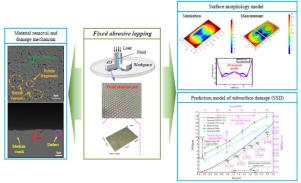International Journal of Mechanical Sciences ( IF 7.1 ) Pub Date : 2021-11-17 , DOI: 10.1016/j.ijmecsci.2021.106941 Lin Bin 1 , Zhang Junpeng 1 , Cao Zhong-Chen 1, 2 , Zhou Jiannan 1 , Huang Tian 2

|
Fixed abrasive lapping (FAL) is a promising technology increasingly used for finishing optical mirrors and molds in a number of materials due to its high finishing efficiency, environmental friendliness, and relatively better surface and subsurface quality. A theoretical model for fixed-abrasive lapping of optical glass was developed in this paper by using indentation fracture mechanics, contact mechanics, mathematical statistics, lapping kinematics, and convolution iterative principle to provide an enhanced scientific understanding of the surface microtopography generation and subsurface damage (SSD) control mechanisms. In the modeling, the influence of the shape, size, and spatial distribution of abrasive particles and the ductile and brittle removal mechanisms of the material were considered. A series of lapping experiments on fused silica glass was carried out to quantitatively analyze the feasibility and accuracy of the model and study the influence mechanism of process parameters on the surface and subsurface state. Results indicated that the models could well predict the surface micromorphology and the SSD depth, and the range of sharpness angle of abrasive particles and tool load affected the predicted SSD range. In addition, the material removal mechanism and lapping tool wear characteristics were revealed by the surface structure and element component analysis. Finally, the FAL process was optimized by the evaluation indices of material removal rate (MRR), surface roughness, and SSD.
中文翻译:

光学玻璃固结磨料研磨表面生成及亚表面损伤的理论与实验研究
固定磨料研磨 (FAL) 是一种很有前途的技术,由于其精加工效率高、环境友好以及相对较好的表面和次表面质量,因此越来越多地用于精加工多种材料的光学镜和模具。本文利用压痕断裂力学、接触力学、数理统计、研磨运动学和卷积迭代原理,建立了光学玻璃固定磨料研磨的理论模型,以增强对表面微形貌生成和次表面损伤的科学理解。 SSD) 控制机制。在建模中,考虑了磨粒的形状、尺寸和空间分布以及材料的延性和脆性去除机制的影响。对熔融石英玻璃进行了一系列研磨实验,定量分析了模型的可行性和准确性,研究了工艺参数对表面和亚表面状态的影响机制。结果表明,该模型可以很好地预测表面微观形貌和SSD深度,磨粒锐角范围和工具负载影响预测的SSD范围。此外,通过表面结构和元素成分分析揭示了材料去除机制和研磨工具磨损特性。最后,通过材料去除率(MRR)、表面粗糙度和SSD的评价指标对FAL工艺进行了优化。











































 京公网安备 11010802027423号
京公网安备 11010802027423号